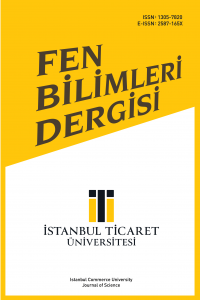Abstract
The aim of this article is to present a new algorithm based on minimum spanning trees. Minimum spanning trees have long been used in data mining, pattern recognition and machine learning. However, it is difficult to apply traditional minimum spanning tree algorithms to a large dataset since the time complexity of the algorithms is quadratic. The given algorithm is designed to reduce this difficulty. This application has reduced the cost.
References
- Referans 1 O. BoruvkaO jistem problemu minimalnim(About a certain minimal problem), Prace mor. prirrodove d. spol. v Brne III(3), (1926), 37--58, (Czech, German summary).
- Referans 2 O. Boruvka,Pirispevek k reseni otazky ekonomicke stavby elekrovodnich siti (Contribution to the solution of a problem of economical construction of electirical networks)}, Elektronicky obzor, 15, (1926), 153--154.
- Referans 3 J. Nesetril, E. Milkova, H. Nesetrilova,Otkar Boruvka on minimum spanning tree problem Translation of both the 1926 papers, comments, history, Dsicrete Math.,233(1-3), (2001), 3--36.
- Referans 4 R.C. Prim, Shortest connection networks and some generalizations, Bell Syst. Tech. J., 36, (1957), 567--574.
- Referans 5 Krishnamoorthy M., Ernst, A.T., Sharaiha, Y.M., Comparison of algorithms for the degree constrained minimum spanning tree, Journal of Heuristics, 7, (2001), 587--611.
- Referans 6 J.B. Kruskal, On the shortest spanning subtree of a graph and the travelling salesman problem, Proc. Amer. Math. Soc., 7, (1956), 8--50.
- Referans 7 http://scanftree.com/Data_Structure/prim\%27s-algorithm.
Abstract
The aim of this article is to
present a new algorithm based on minimum spanning trees. Minimum spanning trees
have long been used in data mining, pattern recognition and machine learning.
However, it is difficult to apply traditional minimum spanning tree algorithms
to a large dataset since the time complexity of the algorithms is quadratic.
The given algorithm is designed to reduce this difficulty. This application has
reduced the cost.
References
- Referans 1 O. BoruvkaO jistem problemu minimalnim(About a certain minimal problem), Prace mor. prirrodove d. spol. v Brne III(3), (1926), 37--58, (Czech, German summary).
- Referans 2 O. Boruvka,Pirispevek k reseni otazky ekonomicke stavby elekrovodnich siti (Contribution to the solution of a problem of economical construction of electirical networks)}, Elektronicky obzor, 15, (1926), 153--154.
- Referans 3 J. Nesetril, E. Milkova, H. Nesetrilova,Otkar Boruvka on minimum spanning tree problem Translation of both the 1926 papers, comments, history, Dsicrete Math.,233(1-3), (2001), 3--36.
- Referans 4 R.C. Prim, Shortest connection networks and some generalizations, Bell Syst. Tech. J., 36, (1957), 567--574.
- Referans 5 Krishnamoorthy M., Ernst, A.T., Sharaiha, Y.M., Comparison of algorithms for the degree constrained minimum spanning tree, Journal of Heuristics, 7, (2001), 587--611.
- Referans 6 J.B. Kruskal, On the shortest spanning subtree of a graph and the travelling salesman problem, Proc. Amer. Math. Soc., 7, (1956), 8--50.
- Referans 7 http://scanftree.com/Data_Structure/prim\%27s-algorithm.
Details
| Subjects | Engineering |
|---|---|
| Journal Section | Research Articles |
| Authors | |
| Publication Date | December 31, 2017 |
| Submission Date | September 14, 2017 |
| Published in Issue | Year 2017 Volume: 16 Issue: 32 |
Cite
 This work is licensed under a Creative Commons Attribution-NonCommercial-NoDerivatives 4.0 International License.
This work is licensed under a Creative Commons Attribution-NonCommercial-NoDerivatives 4.0 International License.

